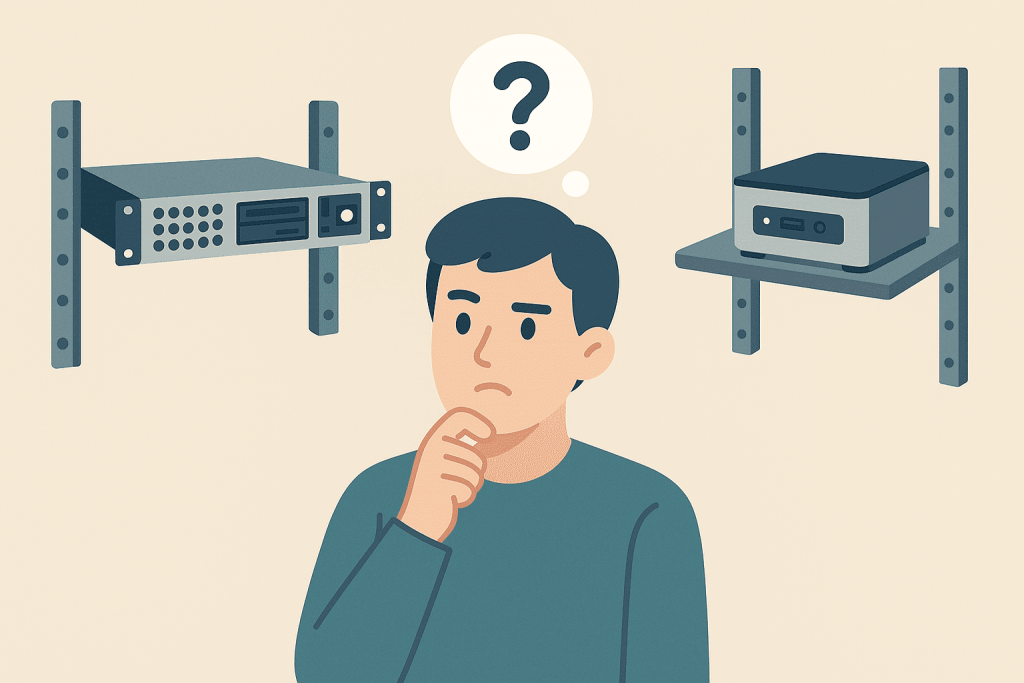
In today’s world, compactness is not just a convenience — it’s a necessity. Companies strive to fit more computing power into smaller spaces, while technical specialists look for ways to optimize performance without sacrificing efficiency. That’s why, alongside traditional rack-mounted server solutions, mini PCs are increasingly appearing — and at first glance, they might seem like a decent alternative. However, there is a significant difference between them — both in purpose and in capability.
What Is a 1U Server
The term 1U refers to the height of the server chassis — just one unit (1.75 inches or about 4.45 cm). These servers are designed for installation in standard 19-inch racks, commonly used in data centers and large IT environments. Despite their modest size, a 1U server is a full-fledged industrial computer equipped with powerful processors, cooling systems, ECC memory (error-correcting code), high-speed storage drives, and network controllers capable of running 24/7.
Inside a 1U chassis, you’ll typically find professional-grade CPUs such as Intel Xeon or AMD EPYC, several RAM slots, two or more drives with RAID support, and redundant power supplies. This hardware is engineered for continuous operation under heavy loads, where failure or overheating is simply not an option.
Mini PCs: Compactness Without Excess
Mini PCs, or compact personal computers, were originally created for office or home use. Later, some models were adapted for rack mounting using shelves or special brackets. They are attractive because of their cost-efficiency: they consume less power, cost significantly less, and take up minimal space.
Usually, mini PCs are equipped with consumer-grade processors (for example, Intel Core or AMD Ryzen), a small amount of RAM, and a single storage drive. They can serve as device controllers, test nodes, or lightweight web servers. However, the main difference lies in their endurance and ability to operate continuously. Mini PCs are not designed for 24/7 workloads — their cooling systems are often limited, and components lack the industrial durability of servers.
Cooling and Ventilation
1U servers are built with high-density installations in mind. When dozens of these units are stacked in a rack, heat is dissipated by powerful fans that push air from the front to the back of the chassis. This design maintains stable temperatures even under heavy workloads.
Mini PCs, on the other hand, often use passive or hybrid cooling systems optimized for quiet operation rather than efficient heat dissipation. If you place several mini PCs in a rack without proper ventilation, the temperature can quickly exceed safe limits, leading to CPU throttling (automatic frequency reduction to prevent overheating) or even system failure.
Networking Capabilities
Another key difference lies in network interfaces. 1U servers typically come with two or more gigabit — and sometimes even 10-gigabit — Ethernet ports. Some models support optical SFP+ modules or include integrated remote management controllers such as IPMI, iDRAC, or iLO.
Mini PCs, by contrast, usually have only one standard network port or even just a Wi-Fi module — suitable for office use, but not for data center environments. The lack of redundant network connections makes them vulnerable to a single point of failure, and the absence of hardware monitoring complicates remote administration.
Reliability and Maintenance
A 1U server is not just a device — it’s a core element of IT infrastructure designed for years of stable operation. Fans, power supplies, and drives can often be replaced without shutting down the system — a feature known as hot-swapping. Mini PCs, however, don’t offer this flexibility: most of their components are soldered onto the motherboard, meaning any repair requires complete shutdown.
In addition, servers provide advanced monitoring interfaces that allow administrators to remotely track temperature, fan speeds, power supply status, and even update the BIOS. Mini PCs lack these capabilities, forcing technicians to physically access the device for every inspection or update.
Power Consumption and Performance
Mini PCs undoubtedly consume less power, but that comes with trade-offs. A single 1U server can outperform several mini PCs thanks to more CPU cores, support for multithreading, greater RAM capacity, and faster SSDs. When hundreds of concurrent tasks or large-scale data processing are required, the server delivers consistent performance without slowdowns.
For simpler tasks — like processing sensor data or managing a smart home system — a mini PC might be the more practical option. But for web services, CRM systems, databases, or virtualization — 1U servers are indispensable.
Summary: When to Choose a Server and When to Choose a Mini PC
The difference between these solutions is not just in size but in purpose. A mini PC is suitable for light workloads, testing environments, and cases where high reliability is not essential. A 1U server, on the other hand, is a professional solution for businesses that value stability, redundancy, scalability, and full control over their infrastructure.
So, if you’re deploying corporate services, web platforms, or projects that demand high availability — server hardware is the right choice. But if you want to experiment with your own hosting setup or test an app in an isolated environment, a virtual server from Server.UA offers the perfect balance: it combines the stability of a real data center with the flexibility that mini PC users often seek.

CozyNova
Really liked your take on compact designs—it’s amazing how space-saving tech can still pack power. It’s nice to see 1U servers and mini PCs finding smart ways to boost efficiency in tight spaces.